 Development Tools
Development Tools
 git
git
 Git tutorial: the difference between git pull and git clone (summary sharing)
Git tutorial: the difference between git pull and git clone (summary sharing)
Git tutorial: the difference between git pull and git clone (summary sharing)
This article brings you knowledge about the difference between git pull and git clone in the Git tutorial. I hope it will be helpful to you.
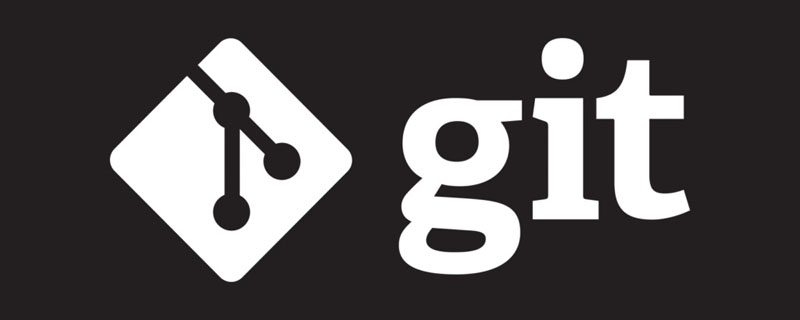
Many people on the Internet explain the difference between pull and clone. They say that pull is to update local code and clone is the process of creating local code from scratch, but there is one thing they did not mention. , I happened to have this problem again today, because I used to pull directly from the remote warehouse, but today I suddenly found that pull cannot be used, and clone only takes effect, and I realized this problem. Decided to record it.
1 git pull
git pull is suitable for pulling down code from the repository that the user has permission to, regardless of whether there is local code.
Because I usually pull down the code directly via git pull.
1.1 Warehouses I have permissions
The warehouses I have permissions refer to my own or the warehouses in my team that I can use .
To use git pull, you must first make sure you are connected to the remote repository. Otherwise, if you directly git pull origin master, Github will ask you: "What master? Which master? Are you my master?"
So you must first connect to the remote warehouse.

init initializes a blank local warehouse, with nothing in it except .git
Connect to the remote warehouse
1.1.1 There is no local code

git remote -v is used to display the remote repository connected to the current local repository. You can connect to several. Then a warehouse exists in pairs, one for upload and one for pull-down. I generally call the origin in the front the name of the remote warehouse, and the one in the back is your connection method.
Now it shows that I am connected to a github remote warehouse named origin.
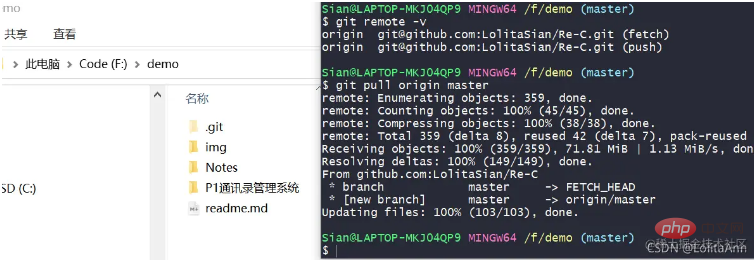
#In a blank warehouse, you can directly use git pull to pull down the code.
1.1.2 Local code
What happens if there is local code?
Team work, one warehouse is used by multiple people
Your own warehouse, you use it on multiple computers (such as one in the dormitory, one in the experiment Room one)
Why do you need git pull? The code version is different on different computers. So in order to reduce work and ensure consistent code versions, pull down the code every time you write code. After writing, push to the remote repository. Draw a picture to explain.
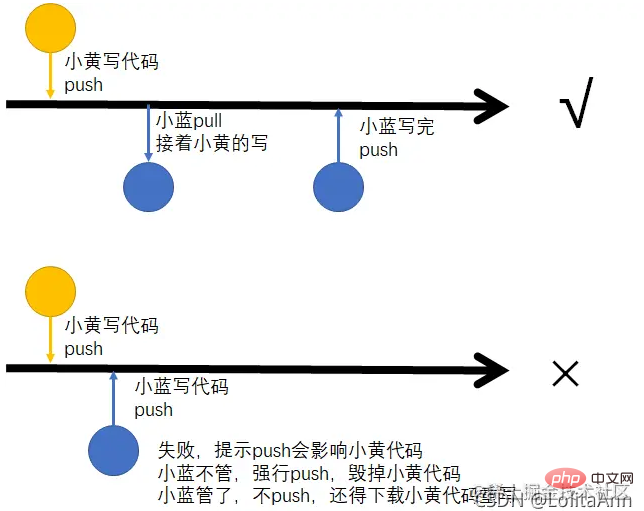
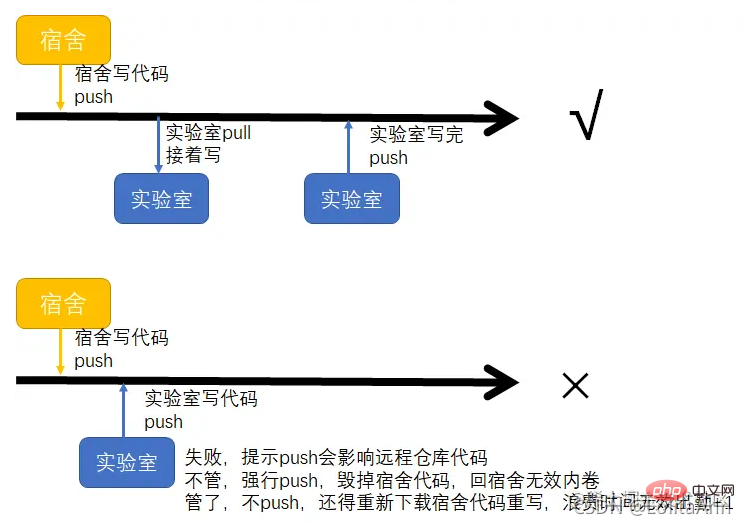
1.2 The warehouse I don’t have permissions
The warehouse I don’t have permissions refers to someone else 's warehouse. If others don't give you permission, of course you can't modify their code at will.
Git pull cannot be used for warehouses without permission. For example:
Today I downloaded the code as usual. But this is my first time downloading someone else's code.

I add the repository link as usual and git pull the drop down. But he prompted me:
Permission denied (publickey).
fatal: Could not read from remote repository.
Please make sure you have the correct access rightsand the repository exists.
Permission denied means that the SSH key cannot be used. Let me confirm whether I have permission to access or whether the repository exists.
The warehouse does exist. So I must not have permission.

Explain the three-step operation:
Add a remote warehouse and connect with SSH
Pull down the code from the master branch of the warehouse
Delete the remote warehouse I added (since it cannot be used, of course I deleted it)
At this time I remembered: SSH is only available to the repository owner. Because the SSH configured on your computer is paired with the SSH on your github, you can use SSH only if you use your github repository on your computer.
Since only the warehouse owner can use SSH, then I can just switch to HTTP. (I haven’t realized the seriousness of the problem at this time)
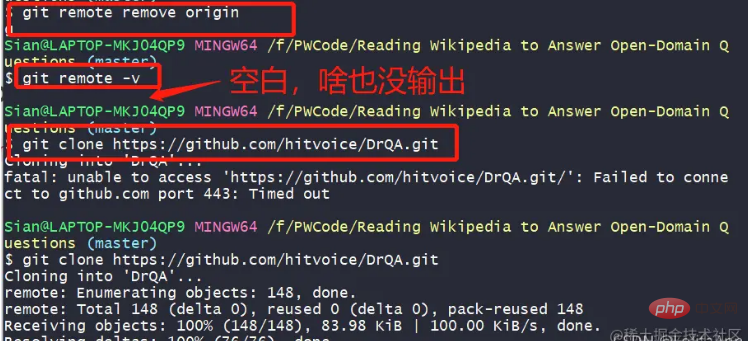
I added an https connection
In the second step, I pulled down the warehouse
Then he prompted me:
fatal: unable to access 'github.com/hitvoice/Dr…': OpenSSL SSL_read: Connection was reset, errno 10054
It means I still can't connect.
At this time I suddenly realized the problem: neutral_face:. This seems to be someone else's warehouse. I can't use remote to connect to the remote warehouse and then pull it down. Because if I can connect, it means I can modify other people's code at will. So I definitely can't pull the code in this way! ! !
So you have to use git clone
2 git clone
git clone is suitable for local code without code, you need to download it. You cannot connect to the remote repository. It can be used with or without warehouse permissions.
Continuing from the above, after realizing the use of git clone, I deleted the HTTPS connection to the remote warehouse just now, and then directly git clone, and the code was successfully downloaded.

I deleted the above https method to connect to the remote warehouse
git remote -v is used to check which remote warehouses your local warehouse is connected to. If When connected, the warehouse code and connection method will be displayed. The output here is blank, which means that no remote warehouse is connected.
git clone downloaded the code successfully.
The above mentioned is someone else’s warehouse, but what if it is a warehouse that I have permission to use?
Create a new local warehouse. It's obviously a success. If SSH can succeed, then HTTPS must succeed. If you can succeed without remote, you will definitely succeed if you use remote.
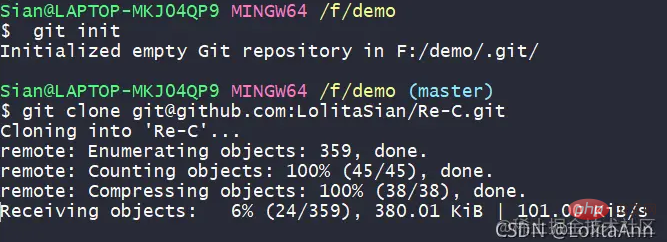
Recommended study: "Git Tutorial"
The above is the detailed content of Git tutorial: the difference between git pull and git clone (summary sharing). For more information, please follow other related articles on the PHP Chinese website!

Hot AI Tools

Undresser.AI Undress
AI-powered app for creating realistic nude photos

AI Clothes Remover
Online AI tool for removing clothes from photos.

Undress AI Tool
Undress images for free

Clothoff.io
AI clothes remover

AI Hentai Generator
Generate AI Hentai for free.

Hot Article

Hot Tools

Notepad++7.3.1
Easy-to-use and free code editor

SublimeText3 Chinese version
Chinese version, very easy to use

Zend Studio 13.0.1
Powerful PHP integrated development environment

Dreamweaver CS6
Visual web development tools

SublimeText3 Mac version
God-level code editing software (SublimeText3)

Hot Topics
 How to install deepseek
Feb 19, 2025 pm 05:48 PM
How to install deepseek
Feb 19, 2025 pm 05:48 PM
There are many ways to install DeepSeek, including: compile from source (for experienced developers) using precompiled packages (for Windows users) using Docker containers (for most convenient, no need to worry about compatibility) No matter which method you choose, Please read the official documents carefully and prepare them fully to avoid unnecessary trouble.
 Summary of FAQs for DeepSeek usage
Feb 19, 2025 pm 03:45 PM
Summary of FAQs for DeepSeek usage
Feb 19, 2025 pm 03:45 PM
DeepSeekAI Tool User Guide and FAQ DeepSeek is a powerful AI intelligent tool. This article will answer some common usage questions to help you get started quickly. FAQ: The difference between different access methods: There is no difference in function between web version, App version and API calls, and App is just a wrapper for web version. The local deployment uses a distillation model, which is slightly inferior to the full version of DeepSeek-R1, but the 32-bit model theoretically has 90% full version capability. What is a tavern? SillyTavern is a front-end interface that requires calling the AI model through API or Ollama. What is breaking limit
 What are the AI tools?
Nov 29, 2024 am 11:11 AM
What are the AI tools?
Nov 29, 2024 am 11:11 AM
AI tools include: Doubao, ChatGPT, Gemini, BlenderBot, etc.
 What are the Grayscale Encryption Trust Funds? Common Grayscale Encryption Trust Funds Inventory
Mar 05, 2025 pm 12:33 PM
What are the Grayscale Encryption Trust Funds? Common Grayscale Encryption Trust Funds Inventory
Mar 05, 2025 pm 12:33 PM
Grayscale Investment: The channel for institutional investors to enter the cryptocurrency market. Grayscale Investment Company provides digital currency investment services to institutions and investors. It allows investors to indirectly participate in cryptocurrency investment through the form of trust funds. The company has launched several crypto trusts, which has attracted widespread market attention, but the impact of these funds on token prices varies significantly. This article will introduce in detail some of Grayscale's major crypto trust funds. Grayscale Major Crypto Trust Funds Available at a glance Grayscale Investment (founded by DigitalCurrencyGroup in 2013) manages a variety of crypto asset trust funds, providing institutional investors and high-net-worth individuals with compliant investment channels. Its main funds include: Zcash (ZEC), SOL,
 Delphi Digital: How to change the new AI economy by parsing the new ElizaOS v2 architecture?
Mar 04, 2025 pm 07:00 PM
Delphi Digital: How to change the new AI economy by parsing the new ElizaOS v2 architecture?
Mar 04, 2025 pm 07:00 PM
ElizaOSv2: Empowering AI and leading the new economy of Web3. AI is evolving from auxiliary tools to independent entities. ElizaOSv2 plays a key role in it, which gives AI the ability to manage funds and operate Web3 businesses. This article will dive into the key innovations of ElizaOSv2 and how it shapes an AI-driven future economy. AI Automation: Going to independently operate ElizaOS was originally an AI framework focusing on Web3 automation. v1 version allows AI to interact with smart contracts and blockchain data, while v2 version achieves significant performance improvements. Instead of just executing simple instructions, AI can independently manage workflows, operate business and develop financial strategies. Architecture upgrade: Enhanced A
 As top market makers enter the crypto market, what impact will Castle Securities have on the industry?
Mar 04, 2025 pm 08:03 PM
As top market makers enter the crypto market, what impact will Castle Securities have on the industry?
Mar 04, 2025 pm 08:03 PM
The entry of top market maker Castle Securities into Bitcoin market maker is a symbol of the maturity of the Bitcoin market and a key step for traditional financial forces to compete for future asset pricing power. At the same time, for retail investors, it may mean the gradual weakening of their voice. On February 25, according to Bloomberg, Citadel Securities is seeking to become a liquidity provider for cryptocurrencies. The company aims to join the list of market makers on various exchanges, including exchanges operated by CoinbaseGlobal, BinanceHoldings and Crypto.com, people familiar with the matter said. Once approved by the exchange, the company initially planned to set up a market maker team outside the United States. This move is not only a sign
 Significantly surpassing SFT, the secret behind o1/DeepSeek-R1 can also be used in multimodal large models
Mar 12, 2025 pm 01:03 PM
Significantly surpassing SFT, the secret behind o1/DeepSeek-R1 can also be used in multimodal large models
Mar 12, 2025 pm 01:03 PM
Researchers from Shanghai Jiaotong University, Shanghai AILab and the Chinese University of Hong Kong have launched the Visual-RFT (Visual Enhancement Fine Tuning) open source project, which requires only a small amount of data to significantly improve the performance of visual language big model (LVLM). Visual-RFT cleverly combines DeepSeek-R1's rule-based reinforcement learning approach with OpenAI's reinforcement fine-tuning (RFT) paradigm, successfully extending this approach from the text field to the visual field. By designing corresponding rule rewards for tasks such as visual subcategorization and object detection, Visual-RFT overcomes the limitations of the DeepSeek-R1 method being limited to text, mathematical reasoning and other fields, providing a new way for LVLM training. Vis
 Bitwise: Businesses Buy Bitcoin A Neglected Big Trend
Mar 05, 2025 pm 02:42 PM
Bitwise: Businesses Buy Bitcoin A Neglected Big Trend
Mar 05, 2025 pm 02:42 PM
Weekly Observation: Businesses Hoarding Bitcoin – A Brewing Change I often point out some overlooked market trends in weekly memos. MicroStrategy's move is a stark example. Many people may say, "MicroStrategy and MichaelSaylor are already well-known, what are you going to pay attention to?" This is true, but many investors regard it as a special case and ignore the deeper market forces behind it. This view is one-sided. In-depth research on the adoption of Bitcoin as a reserve asset in recent months shows that this is not an isolated case, but a major trend that is emerging. I predict that in the next 12-18 months, hundreds of companies will follow suit and buy large quantities of Bitcoin





